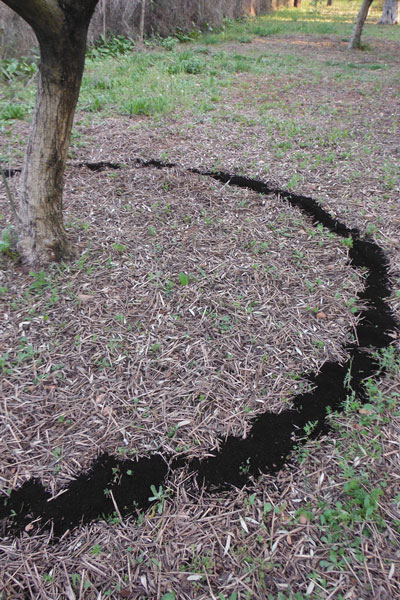Application
A lot of farmers consider compost only as a source of nutrients for their soils. The truth is that Bio Agro Oliva provides a lot more than just nutrients by inoculating the soil with various microorganisms and through the high content of organic matter. Apart from fertilizing, it contributes to the health of the plants and the retention of soil nutrients and water, as well. Bio Agro Oliva can be considered as a sort of "yeast" that even in small quantities can give remarkable results.
The dosage mentioned further down is indicative and may be increased or decreased depending on soil, irrigation, spacing of plants, age, condition and yield of the crop, climate, etc. For professional use, an initial soil analysis is recommended, in order to calculate with accuracy the quantity of required Bio Agro Oliva and possible complementary nutrients from other sources.
Superficial incorporation of Bio Agro Oliva with appropriate machines or tools is proposed (disc harrow, cultivator, digging), depending on the case. Bio Agro Oliva should not be buried deeper than 10cm, as microorganisms need air to work.
The best time for fertilizing is just before the starting of the cultivation period. When plant growth starts, Bio Agro Oliva should be close to their roots.
For olive trees, vines and perennial plants, fertilizing is carried out late in winter (at the start of pruning). For annual crops, the time of fertilizing coincides with the cultivation of the soil before seeding or planting. In case Bio Agro Oliva is only used on the soil surface, without incorporation into the soil (for example, in a ditch around the plant), the results take some months to become evident.
Bio Agro Oliva can be used as a substrate component in seedbeds and pots, together with other materials (soil, peat, perlite, etc.). The percentage in the final mixture varies, depending on the use of the substrate.
There are no problems if Bio Agro Oliva is overdosed. Plants can grow even in a substrate composed of 100% Bio Agro Oliva. However, the European Union has enforced a peak application limit for the protection of ground waters from nitrogen pollution. This limit (17kg of nitrogen/1000m2 or 1080kg/1000m2 of Bio Agro Oliva) applies to some crops (for example, organic agriculture in some EU countries) or to certain sensitive regions.

Application rates
- Up to 5 years : 2 – 8 kg/tree
- Older than 5 years: 5 – 15 kg/tree (1500-4000 kg/ha)
- Mature tree with high yield: up to 40 kg/tree.
Note: As a general rule, 40-60% of olives' weight should be returned to the tree as Bio Agro Oliva
- Wine grapes: 0.6-1.5 kg/vine (2500 kg/ha)
- Table grapes: up to 2.5 kg/vine
- Up to 5 years: 2 – 10 kg/tree
- Older than 5 years: 5 – 20 kg/tree (3000-6000 kg/ha)
- Mature tree with high yield (cherry tree): up to 40 kg/tree
- Dry farming (wheat, sunflower) 4000 – 8000 kg/ha
- Irrigation farming (cotton) 8000-15000kg/ha
- Irrigation farming (corn) 15000-20000kg/ha
- Tomato 8000 – 20000 kg/ha
- Pepper 6000 – 12000 kg/ha
- Cucumber 6000 – 10000 kg/ha
- Eggplant 6000 –12000 kg/ha
- Lettuce 5000 – 10000kg/ha
- Tomato 5000 – 15000kg/ha
- Cucumber 5000 – 12000kg/ha
- Eggplant, pepper 5000 – 14000kg/ha
- Potato 9000 – 18000kg/ha
- Strawberry 5000 – 6000kg/ha
- Carrot 5000 – 8000kg/ha
- Cabbage 8000 – 17000kg/ha
- Pumpkin 7000 – 18000kg/ha
- Onion 5000 – 9000kg/ha
- Green beans 3000 – 9000kg/ha
- Okra 3000 – 8000kg/ha
- Spinach 5000-12000kg/ha
- Lettuce, green beans, aromatic plants 0.3kg/m2
- Tomato, spinach 0.5kg/m2
- Cucumber, carrot, strawberry, okra, onion 0.4kg/m2
- Pumpkins 0.7kg/m2
- Potato, cabbage, zucchini 0.8kg/m2
- Lawn 0.4 – 1kg/m2
- Rock garden plants 0.1-0.2kg/m2
- Ornamental plants 0.3kg/m2
- Roses 0.8kg/m2
- Flowers and various annual plants 0.6-0.7kg/m2
- Outdoor ornamental plants 20-30% w/w in a mixture with soil, peat and perlite
- Rose bush 20% w/w in a mixture with peat and red soil
- Ficus 20% w/w in a mixture with peat
- Basil 20% w/w in a mixture with peat
- Oregano 25-30% w/w in a mixture with black peat
- Forest plants (pine, cypress, eucalyptus, acacia, oleander, angelica) 25-30% w/w in a mixture with soil
- Fruit trees (plum, apple, pomegranate, cherry, pear) 25-30% w/w in a mixture with soil
- Citrus trees (orange, bitter orange, grapefruit, tangerine, lemon) 25-40% w/w in a mixture with peat, soil, perlite
- Olive tree 30-60% in a mixture with soil or black peat
